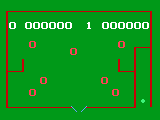Pinball is an engineering prototype that sat, forgotten, in Ralph Baer's basement for about 20 years before it was finally recovered. Thirty cartridge copies were produced, with labels specially made and autographed by Baer, and sold for $25 apiece at Classic Gaming Expo 2000. The significance of this game cannot be understood without first understanding the significance of the man behind it.
Ralph Baer invented videogames. He may or may not have been the first person to come up with the concept of games to be played on a TV screen, but he was the first to follow through on it and design a working game device. By 1971, he had sold the device to Magnavox, who released it as the Odyssey, the very first home videogame system.
Later, Baer had a hand in the creation of the Odyssey². Magnavox had launched a project to develop a "next-generation" game console. They ordered chipsets from Intel and hired an engineering staff to work on the project. The machine had begun to take shape when the company suddenly abandoned the project. Baer, who worked for the military electronics firm Sanders Associates, got wind and flew out to Tennessee to meet with Magnavox management. Long story short, he helped convince them to continue their project and Odyssey² was born.
Sanders Associates had already worked with Magnavox on the Odyssey, and was interested in developing games for the new machine. That's where Pinball comes in. Judging from comments made by Baer and by the organizers of the Classic Gaming Expo, Pinball was more of a laboratory test than a marketable game. It was done as a learning exercise about Odyssey² programming and graphics. No plans were ever made to turn it into a commercial product. As it stands now, it really couldn't have been marketed.
Pinball apparently discouraged Sanders from future O2 development (that's not surprising – everyone who has tried to program the Odyssey² has commented on how difficult it is), and Pinball was the only O2 project Sanders ever undertook. Baer's lone prototype was the only one in existence (at least, the only one that is known about) until the CGE copies were made.
The Game
When you power up Pinball, the first thing you see is the ever-present SELECT GAME screen. Press 0-9 and you get the message "NUMBER OF PLAYERS." Enter 1 or 2 and you will be told to select a game FORMAT. Press 0-9 to start playing a game.
The "table" in Pinball is rectangular. You launch the ball by pulling back on the right hand controller, although you control the flippers with the left. The ball bounces when it strikes a bumper (represented by a letter "O"). Each bumper strike nets you 75 points. The bumper will change color and sometimes holes will open up at the bottom of the table, through which you can lose your ball. At the bottom center of the table, you have two small flippers that can launch the ball back toward the top of the table. And that is pretty much a game of Pinball.
There is a "nudge" feature. Press the joystick to nudge the table in a specific direction. The bumpers move to indicate you've nudged the table, but it seems to have a negligible effect on the ball. Maybe this feature wasn't completed yet. There doesn't seem to be any kind of "Tilt" penalty for nudging too much either.
In terms of play, Pinball has major potential but would have required a lot more work before becoming a really enjoyable game. Unfortunately, it doesn't surpass the Odyssey²'s existing – and rather mediocre – pinball cartridge, Thunderball. It does have some things going for it, however. I liked the smaller graphics (as opposed to the bowling-ball sized ball used in Thunderball). This could have allowed for a greater number of on-screen targets, but Pinball doesn't have them in its current state.
Probably the best feature of Pinball is the second game format, which lets you set up your own table! When you start this format, you get a screen with some coordinate points to help you line things up. Using the joystick, you can maneuver the bumpers and place them wherever you like. Once you've placed them all, the game starts as normal. If you ever played Bill Budge's classic Pinball Construction Set, you know how much fun a feature like this can be. Imagine if Pinball had featured lots of drop-down targets and rollovers? That really would have put Thunderball to shame!
The game's ROM has been dumped, and it will function in the O2EM emulator. It is also included on the latest Odyssey² Multicart. But even if you don't have the ROM or the Multicart, you're not missing much from a "fun game" standpoint. Still, my Pinball cart is one of my most prized possessions and I'm extremely grateful I was able to obtain a copy.
Since the game wasn't released, it doesn't have a commercial label. The label that came on the CGE copies was produced by the CGE organizer who made the cartridges. The screenshot at the top of the page isn't an actual photo; it's an image I created while looking at the game screen. It's accurate except the colors may be a little darker than in the actual game.
Back in 2000, I wrote a long summation of Ralph Baer's CGE keynote lecture for Classicgaming.com. Sadly the site is defunct now, but you can still find some of it at archive.org. It has tons of fascinating information and is still worth a read!

 SENDING...
SENDING...